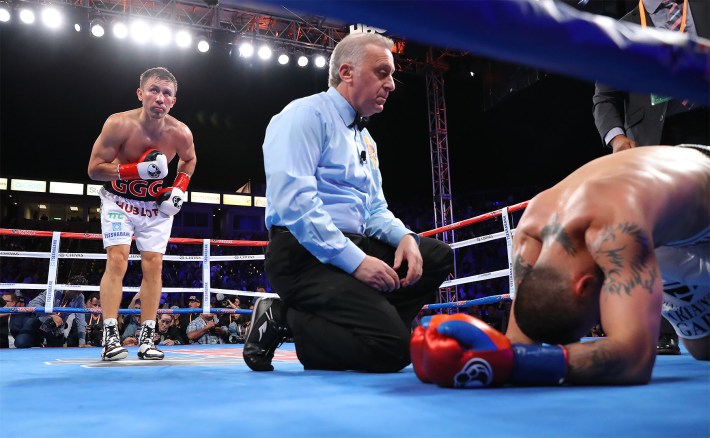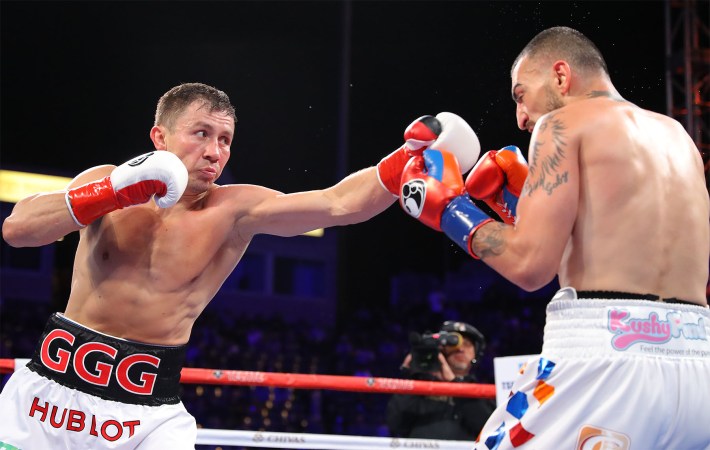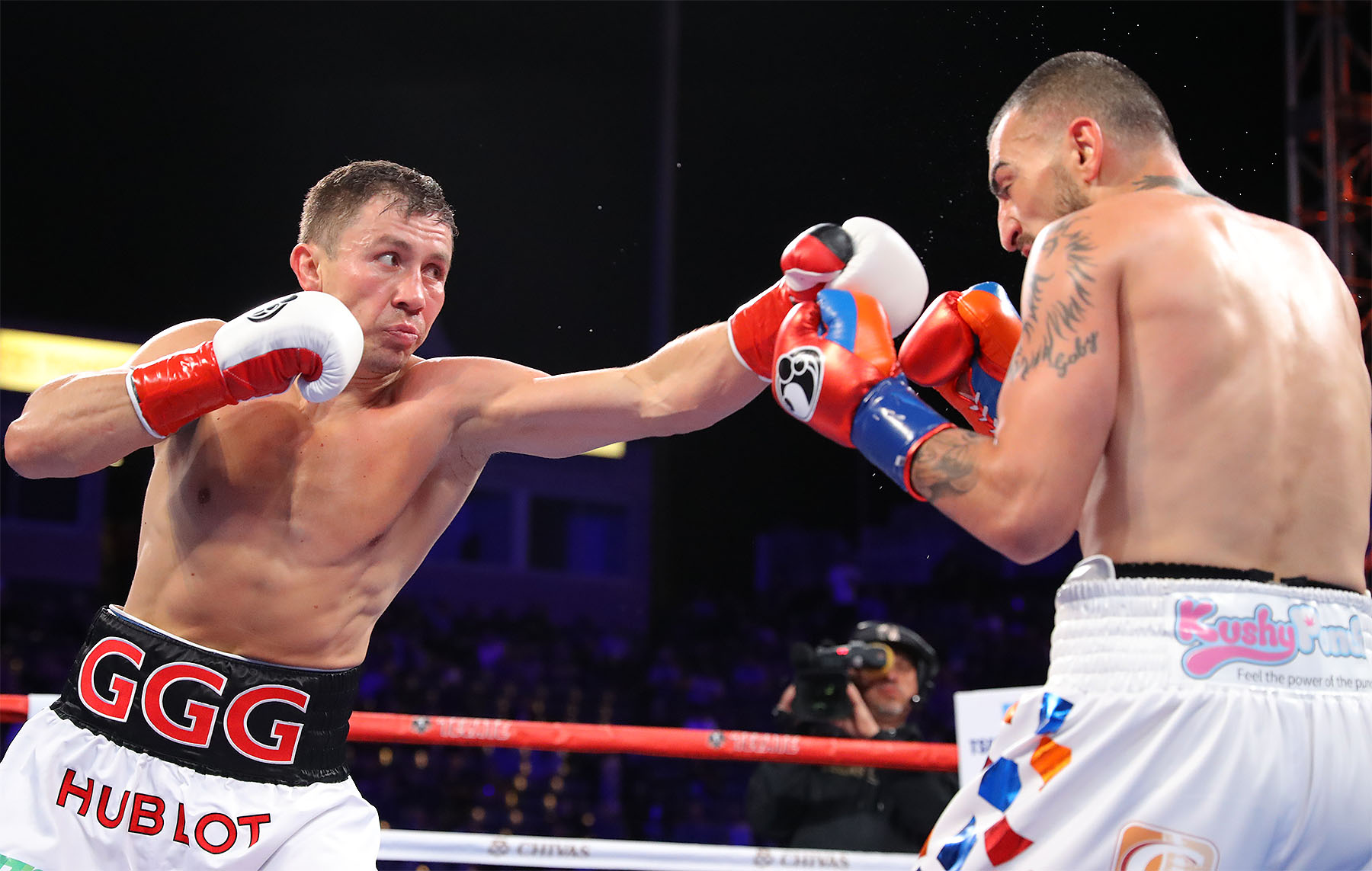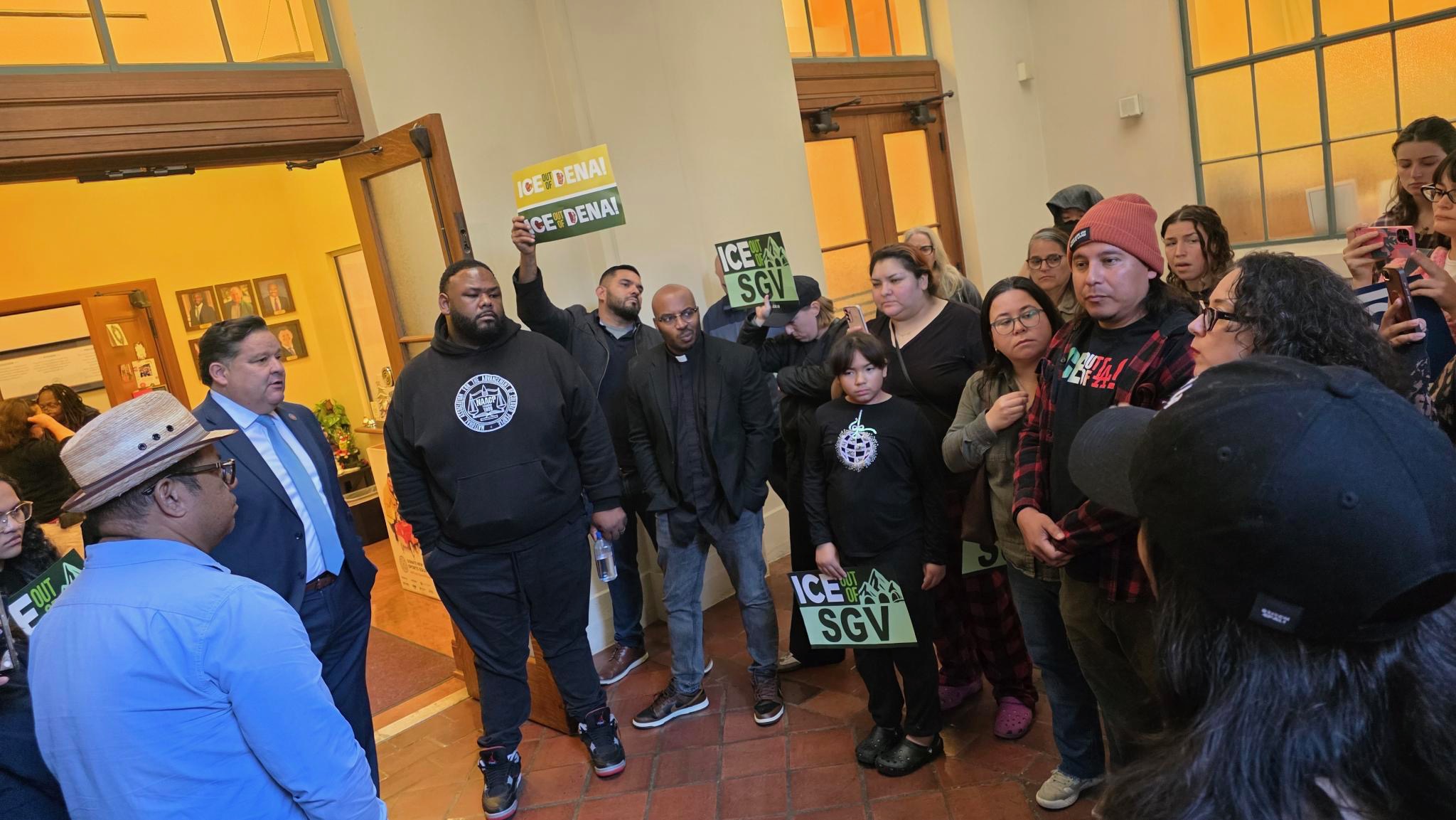[dropcap size=big]T[/dropcap]he moon was high and luminous, the energy of the record-breaking crowd was too, and Triple G — Gennady Gennadyevich Golovkin — was taking a victory lap, saluting hordes of fans with his four world boxing championship belts raised behind him as he strutted around the StubHub Center ring on Cinco de Mayo in the South Bay city of Carson.
Triple G hadn’t even stepped in the ring yet and he was already the undisputed king of Los Angeles, where champions like Kobe Bryant, Magic Johnson, Fernando Valenzuela and Marcus Allen once reigned. To many in the worlds where sports and Los Angeles intersect, Triple G sits on that throne now.
This was moments before the half-Korean, so-called “honorary Mexican” and Kazakhstani immigrant would step into the ring and dismantle his Armenian-American opponent Vanes “The Nightmare” Martirosyan. It happened in less than two rounds and 36 punches. This was minutes before he would tell HBO’s Max Kellerman to bring on Mexican superstar Saul “Canelo” Alvarez. And it was an hour before his celebratory press conference where he would tell L.A. Taco that fighting before the mostly Mexican-American crowd on the mostly Mexican-American holiday was like fighting in front of his family.
But in order to fully capture the impact and embrace of Triple G by Latino Los Angeles, we have to go back two weeks earlier, when there wasn’t even supposed to be a fight and the drama that only the Sport of Kings can provide that led up to that.

Alvarez vs Golovkin II, arguably the most anticipated rematch since the days of Marquez v. Pacquiao or Morales v. Barrera, was supposed to take place in the boxing capital of the world, Las Vegas, on the biggest boxing weekend of the year, Cinco de Mayo.
Negotiations for the fight started immediately after the controversial draw in September of 2017 where we first saw Golovkin’s massive popularity among Mexican and Mexican-American boxing fans, who almost always support the Mexican boxer in the fight.
Homes were divided, fan Diego Cerda explained to L.A. Taco on Friday morning at the LAX Sheraton. Cerda and his mom Consuelo were on hand to catch a glimpse of Triple G at the official weigh in. “Triple G won that fight, 100 percent,” Los Angeles native Cerda said smiling over his senior citizen mother. But Consuelo, a little viejita in a wheelchair from the Mexican state of Jalisco, was equally sure her fellow Jalisciense Canelo won the fight.
“Gano Canelo,” she smiled up at her son.
This back and forth in the boxing community and among its fans has dominated the conversations on Twitter and the boxing blogosphere for months on end. It hit a tipping point last month when Alvarez was suspended by the Nevada State Athletic Commission for second positive test of the banned substance clenbuterol.
Alvarez would claim the two positive tests were a result of tainted Mexican meat. Golovkin would say he eats “Mexican meat too” at the Hacienda Grill in Big Bear, where GGG trains with his famed Mexican boxing trainer Abel Sanchez. “We we eat steaks at the Hacienda all the time,” Sanchez grinned at the room full of reporters at StubHub Saturday night, before pointing out that Golovkin has never tested positive for a banned substance.
Alvarez was suspended for six months, backdated by the commission to February 17, and the mega rematch was off. Cinco de Mayo weekend would lack a marquee boxing match for the first time since Mexican boxing legend Julio Cesar Chavez Sr began the tradition in the early 90s, and Oscar De La Hoya popularized it in the early aughts.
But Triple G would not have it. He told his promoter Tom Loeffler and his team to make the fight happen. After a bunch of false starts, Don King, the man involved in making many of those historic Cinco de Mayo matches take place, stepped in with an opponent for Triple G.

Two weeks later, in the lobby of the LAX Sheraton dressed in a bedazzled stone washed denim jacket adorned with a giant pin of the current U.S. president, King told L.A. Taco and several camera-weidling journalists it was an honor to fight on the Cinco de Mayo holiday before rattling off a list of battles and names from the canon of Mexican Revolution history.
A few feet away from King in an unassuming striped polo stood the Baby Faced Assassin, Mexican boxing legend and 4 time champion Marco Antonio Barrera, who told L.A. Taco Golovkin is an honorary Mexican.
“We are proud to embrace him because of his personality and his style,” Barrera said grinning from ear to ear. Now 44, there are no signs of the battle wounds from his legendary three-fight war with Eric “El Terrible” Morales.

The Mexican style Barrera was referring to, is a straightforward relentless fighting style that puts pressure on the opponents and is underscored by a killer left hook and powerful jab, Barrera explained. The style was made famous by Chavez Sr. and became a cornerstone of modern boxing success for many of Mexico's great champions.
“Triple G is a guy who grew up admiring Mexican boxers and wanting to be Mexican,” Barrera added. “And he loves our culture and we love him back.”
Before the fight, Don King told L.A. Taco his client Martirosyan was going to “shock the world” and live up to his Nightmare nickname. King was holding half a dozen small flags, including the Mexican, Armenian, and American ones.
A little over 24 hours later, the Tecates were flowing, churros crunching, and the music, an eclectic mix of Latin gems and hip-hop bangers, set the stage. Martirosyan, who is from Glendale, came in to a mix of boos and cheers followed by the Armenian and Mexican flags.
A quick cameo by comedian Dave Chappelle, who looked a bit lost looking for his seats, seemed to last longer than Martirosyan would last in the ring.
The slow motion replay of Triple G’s five-punch combo in the second round at 1 minute, 53 seconds played to “oohs” and “ahhs” in the arena.
An uppercut. Two straight rights. And two left hooks.
Mexican style. And it was over.

ALSO BY THE AUTHOR:
How a 'Lil Libros' on Selena Quintanilla Shot to the Top of Amazon's Best Seller List
'Taco Trucks At Every Mo
‘Black Panther’ and ‘Coco’ Prove Diversity Is Good for Movie Business, Panel Says







